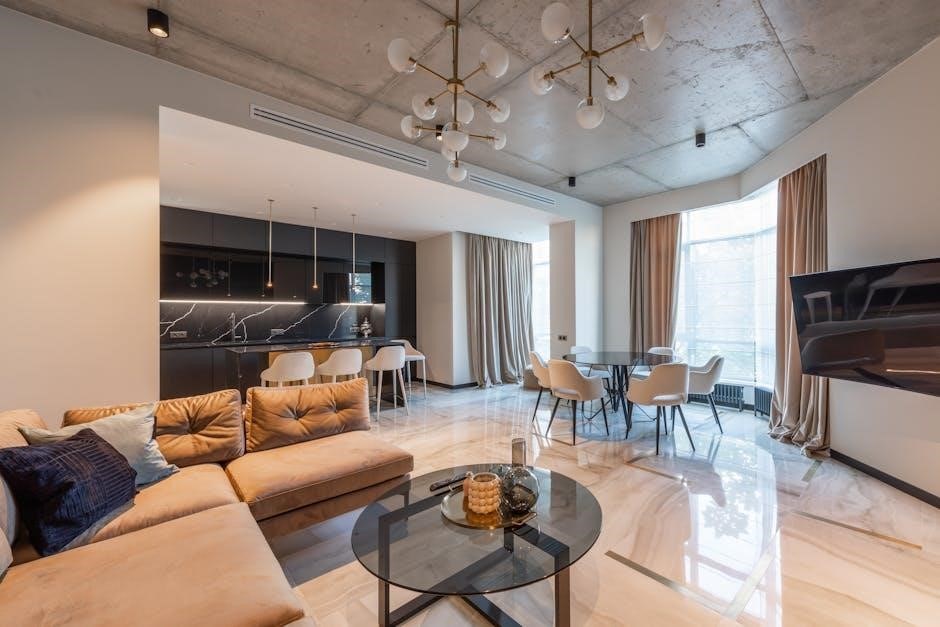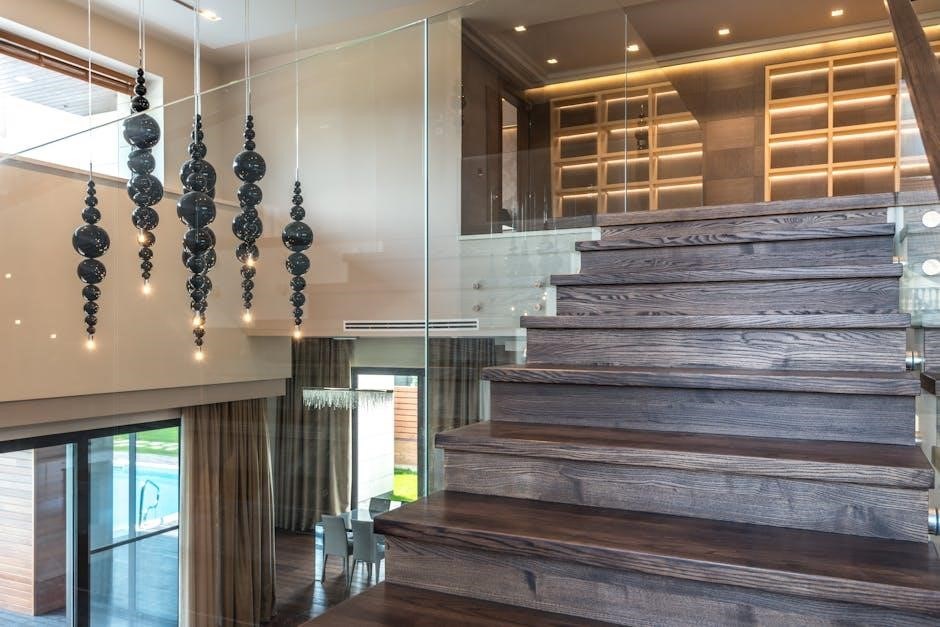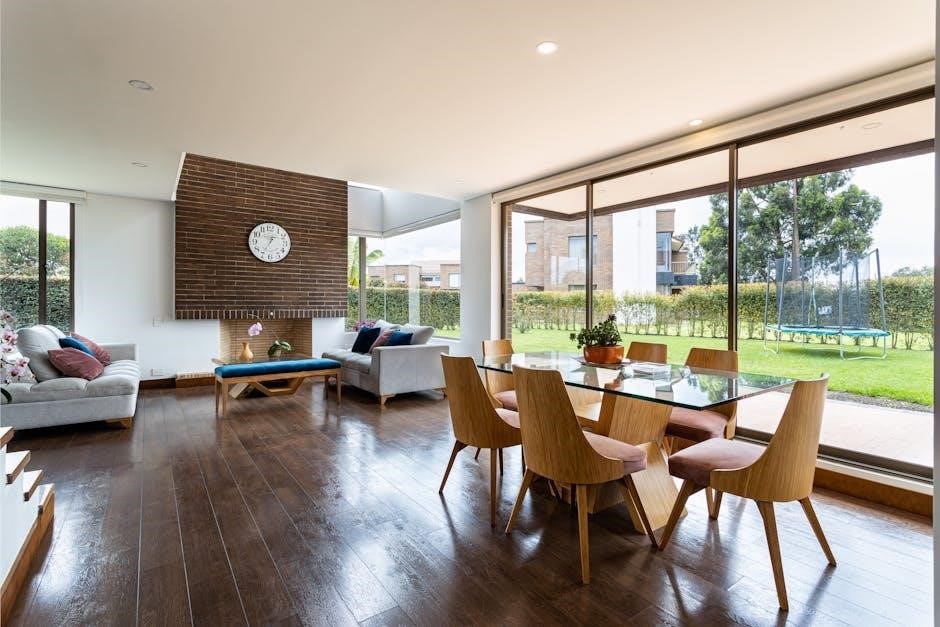House plans in PDF format offer a versatile and accessible way to visualize and construct homes, providing detailed layouts for various spaces and design preferences efficiently․
What Are House Plans in PDF Format?
House plans in PDF format are detailed architectural documents that outline the design and structure of a home․ They include floor layouts, room dimensions, and other essential details for construction․ These plans are widely available in various sizes, such as 1 BHK, 2 BHK, and 3 BHK, catering to different plot sizes and design preferences․ Modern and traditional designs are also accessible, offering flexibility for homeowners․ The PDF format ensures clarity and convenience, allowing users to easily download, print, and share the plans․ Many websites provide free downloads, making it simple to find and customize the perfect house plan for individual needs․
Why Choose PDF Format for House Plans?
The PDF format is a highly preferred choice for house plans due to its universal compatibility, clarity, and ease of use․ It ensures that architectural designs remain consistent across different devices and software, maintaining the integrity of the layout and details․ PDF files are also cost-effective, as they eliminate the need for physical blueprints and can be easily shared with contractors and stakeholders․ Additionally, PDFs are environmentally friendly, reducing the reliance on paper․ Their accessibility and convenience make them ideal for homeowners and builders alike, providing a seamless experience in planning and executing construction projects efficiently․

Benefits of Using House Plans in PDF Format
PDF house plans offer cost-effectiveness, accessibility, and customization, ensuring clarity and ease of sharing while being environmentally friendly for seamless construction planning and execution․
Cost-Effectiveness of PDF House Plans
PDF house plans are a budget-friendly option for homeowners and builders, offering significant savings compared to traditional printed blueprints․ They eliminate the need for physical copies, reducing printing costs and allowing instant digital access․ Many websites provide free downloadable PDF plans, such as the 2045 sq․ft․, 3050 sq․ft․, and 1530 sq․ft․ designs, making it easier to explore various layouts without financial strain․ Additionally, customizable PDF plans enable users to adapt designs to their needs without extra costs․ This affordability makes PDF house plans a practical choice for individuals seeking to construct or renovate homes efficiently․ They are a cost-effective solution for modern construction needs․
Accessibility and Convenience of PDF Files
PDF files offer unparalleled accessibility and convenience for house plans, enabling users to access designs from anywhere with an internet connection․ They can be easily downloaded, shared, and viewed on various devices, including smartphones, tablets, and computers, without requiring specialized software․ Websites like American Design Concepts provide instant downloads, allowing homeowners to quickly obtain and review plans․ PDFs are also scalable, making it simple to zoom in on details or print specific sections․ This portability and ease of use make PDF house plans an ideal choice for architects, contractors, and homeowners seeking flexibility and efficiency in their construction projects․ Their universal compatibility ensures seamless collaboration and accessibility across different platforms and locations․
Customization Options for PDF House Plans
PDF house plans offer robust customization options, allowing users to tailor designs to their preferences․ Homeowners can select specific packages, such as PDF or CAD formats, depending on their needs․ PDF plans are ideal for minor adjustments, while CAD files enable extensive modifications․ Many websites provide customizable templates, enabling users to tweak floor layouts, add rooms, or incorporate design features like Vaastu-compliant elements․ Some platforms even offer professional customization services, ensuring plans meet individual requirements․ This flexibility makes PDF house plans adaptable to various budgets, plot sizes, and architectural styles, providing a personalized solution for constructing dream homes with ease and efficiency․ This ensures that each plan is uniquely suited to its user’s vision and needs․

Types of House Plans Available in PDF
House plans in PDF format are diverse, offering 1 BHK, 2 BHK, and 3 BHK layouts, along with small designs like 20×30 and 30×50, modern and traditional styles, and specific options such as 2045 ft, 3050 ft, and 1530 ft plans․
1 BHK, 2 BHK, and 3 BHK House Plans
1 BHK, 2 BHK, and 3 BHK house plans are popular configurations offering compact yet functional living spaces․ These layouts cater to small families, couples, or individuals, providing efficient room distributions․ A 1 BHK includes a single bedroom, living area, kitchen, and bathroom, ideal for minimalists․ 2 BHK plans add an extra bedroom, offering more space for growing families․ 3 BHK designs are perfect for larger families, with three bedrooms and ample living areas․ These plans are available in PDF format, ensuring easy access and customization․ Many websites offer free downloads, such as 2045 ft, 3050 ft, and 1530 ft plans, tailored to various plot sizes and budgets, with options for Vaastu-compliant designs to suit cultural preferences․
Small House Plans (e․g․, 20×30, 30×50)
Small house plans, such as 20×30 and 30×50 layouts, are ideal for compact living spaces, offering efficient designs for limited plot sizes․ These plans are popular due to their affordability and practicality, catering to small families or individuals seeking cozy homes․ The 20×30 plan provides a manageable footprint, while the 30×50 option offers slightly more space without compromising on simplicity․ Available in PDF format, these plans are easily downloadable and customizable, ensuring they meet specific needs․ Websites offer free downloads, such as 2045 ft and 1530 ft plans, making it convenient to find the perfect layout for your dream home․ These designs emphasize smart space utilization, blending functionality with aesthetics for a comfortable living experience․
Modern and Traditional House Designs
Modern and traditional house designs in PDF format cater to diverse architectural preferences, offering a blend of contemporary and classic styles․ These plans are tailored to suit various tastes, from sleek, minimalist modern homes to timeless, intricate traditional designs․ Available in PDF, they provide detailed layouts, including floor plans and elevations, ensuring clarity and ease of use․ Many websites offer free downloads of these designs, such as 2045 ft and 1530 ft plans, which can be customized to meet individual needs․ Whether you prefer open-concept modern spaces or cozy traditional layouts, these PDF plans are accessible and adaptable, making them ideal for constructing your dream home with precision and style․

How to Download Free House Plans in PDF
Downloading free house plans in PDF is straightforward․ Visit reputable websites, select your preferred design, and follow the download instructions for instant access to detailed layouts․
Popular Websites for Free House Plan Downloads
Several websites offer free house plans in PDF format, catering to diverse needs․ Websites like www․indianplans․in provide 1 BHK, 2 BHK, and 3 BHK plans compliant with Vaastu․ Pinterest and other design platforms showcase a wide range of modern and traditional designs․ Some sites, such as American Design Concepts, offer free downloads alongside options for custom plans․ Additionally, resources like Joshs House provide free-to-use and shareable PDF plans․ These platforms allow users to explore, preview, and download detailed house blueprints, making it easier to find the perfect layout for their dream home without any cost or registration requirements․
Steps to Download and Print PDF House Plans
Downloading and printing PDF house plans is straightforward․ Visit a reliable website, such as www․indianplans․in or American Design Concepts, and browse their catalog․ Select a plan that suits your needs, then click the download link․ Ensure you have a PDF viewer installed to open the file․ Review the plan, check for scalability, and ensure it meets your requirements․ Print the PDF on standard paper or scale it to larger formats like 24×36 inches for detailed viewing․ Some plans may include watermarks for non-construction use, so verify the terms before printing․ This process allows you to easily access and utilize your chosen house plan for planning or construction purposes․
Free House Plan Examples (e․g․, 2045 ft, 3050 ft, 1530 ft)
Free house plan examples like the 2045 sq․ft․, 3050 sq․ft․, and 1530 sq․ft․ designs offer diverse options for homeowners․ The 2045 sq․ft․ plan features a modern layout with 4 bedrooms and 4 baths, ideal for larger families․ The 3050 sq․ft․ plan provides ample space for luxurious living, while the 1530 sq․ft․ plan is perfect for smaller plots or budget-friendly construction․ These plans are available for instant download in PDF format from websites like American Design Concepts and indianplans․in․ They include detailed floor layouts, room dimensions, and exterior-interior design features, ensuring you can visualize and plan your dream home․ These examples cater to various needs, whether modern or traditional, and are ready for printing and sharing with contractors․

Tools and Software for Viewing and Editing PDF House Plans
Use Adobe Acrobat or Foxit Reader to view PDF house plans․ For editing, CAD software or AutoCAD allows customization, ensuring precise modifications for construction needs․
Best PDF Viewers for House Plans

The best PDF viewers for house plans include Adobe Acrobat Reader, Foxit Reader, and SumatraPDF․ These tools provide clear zoom functionality, measurement features, and annotation options, essential for reviewing architectural details․ Adobe Acrobat stands out for its advanced features like rulers and layers, while Foxit Reader offers a lightweight yet powerful interface․ Both are compatible with Windows, macOS, and mobile devices, ensuring accessibility across platforms․ These viewers are widely used in construction and design industries for their reliability and user-friendly navigation․ They support large-format PDFs, making them ideal for detailed house plans and blueprints․ Choose the one that suits your needs for seamless viewing and collaboration․
Software for Customizing House Plans
Software like Adobe Acrobat, AutoCAD, and Sweet Home 3D are excellent for customizing house plans in PDF format․ Adobe Acrobat allows editing text, adding annotations, and modifying layouts․ AutoCAD is ideal for precise architectural adjustments, offering tools for resizing rooms and adjusting dimensions․ Sweet Home 3D provides a user-friendly interface for creating and modifying floor plans․ Additionally, SolidWorks and SketchUp are popular for 3D modeling and customizations․ These tools enable users to tailor house plans to their preferences, ensuring the final design meets specific needs and requirements․ They are widely used by professionals and DIY enthusiasts alike for their flexibility and powerful features․ Choose the software that best fits your design and customization goals for optimal results․

Advantages of PDF Format for Construction
PDF house plans offer clarity, consistency, and security, ensuring precise construction details․ They maintain formatting across devices, preventing errors and misinterpretations, while enabling easy sharing and compliance with building standards․
Clarity and Detail in PDF Blueprints
PDF blueprints provide exceptional clarity and detail, ensuring precise measurements and layouts․ High-resolution images and layered diagrams allow for easy interpretation of construction elements․ The format retains consistency across devices, preventing misinterpretations․ Architects and contractors can zoom in for intricate details, while search functionality helps locate specific sections quickly․ This level of precision ensures accuracy in construction, reducing errors and enhancing collaboration․ PDFs also support annotations, enabling teams to mark changes without altering the original design, thus maintaining the integrity of the blueprint․ This clarity is essential for successful project execution, making PDFs a reliable choice for construction professionals․
Ease of Sharing PDF Plans with Contractors
PDF house plans are effortlessly shared with contractors via email or cloud storage, ensuring seamless communication․ The universal compatibility of PDFs means contractors can view plans on any device without special software, speeding up project coordination․ Password protection enhances security, allowing controlled access to sensitive information․ Teams can annotate and comment directly on the PDF, fostering clear feedback and collaboration․ This ease of sharing reduces misunderstandings and delays, ensuring all parties are aligned․ Contractors can also print PDFs for on-site reference, maintaining consistency between digital and physical copies․ The simplicity of sharing PDF plans streamlines workflows, making them an essential tool for efficient project management․
Environmentally Friendly Option
House plans in PDF format are an eco-friendly choice, reducing the need for physical paper and ink․ Digital storage and sharing via email or cloud platforms minimize environmental impact․ PDFs eliminate the need for bulky blueprints, saving trees and lowering carbon footprints․ Architects and designers can create and share plans without printing, promoting sustainable practices․ Additionally, PDFs can be easily updated without wasting resources, making them a greener alternative to traditional methods․ This digital approach aligns with global efforts to reduce paper consumption and supports environmentally responsible construction practices․ Choosing PDF house plans is a simple yet effective way to contribute to a more sustainable future․
Design Elements to Look for in PDF House Plans

When exploring PDF house plans, key design elements include detailed floor layouts, precise room dimensions, and both exterior and interior design features․ Vaastu-compliant plans are also available․
Floor Layouts and Room Dimensions
Floor layouts and room dimensions are essential components of PDF house plans, providing a clear visual representation of spaces․ These plans detail room sizes, door and window placements, and overall spatial arrangements․ For instance, 1 BHK, 2 BHK, and 3 BHK plans outline compact to spacious living configurations․ Small house plans, such as 20×30 or 30×50 layouts, offer efficient use of space․ PDFs often include precise measurements, ensuring clarity for construction․ Whether it’s a 2045 sq․ ft․ modern design or a 1530 sq․ ft․ traditional layout, these plans cater to diverse needs․ Customization options allow adjustments to suit specific preferences, making PDF house plans versatile and practical for builders and homeowners alike․
Exterior and Interior Design Features
PDF house plans often include detailed exterior and interior design features, showcasing a blend of modern and traditional aesthetics․ These plans highlight architectural elements like facades, window styles, and door placements, ensuring a visually appealing exterior․ Interior features such as kitchen layouts, bathroom designs, and living areas are also meticulously outlined․ For example, a 2045 sq․ ft․ house plan might feature an open-concept living space, while a 3050 sq․ ft․ design could include multiple balconies and decks․ Customization options allow homeowners to tailor these features to their preferences, whether it’s a sleek modern look or a cozy traditional vibe․ Additionally, some PDF plans offer 3D views for a better understanding of the design․
Vaastu-Compliant House Plans
Vaastu-compliant house plans in PDF format are designed to align with ancient Indian architectural principles, ensuring harmony and balance in living spaces․ These plans emphasize proper placement of rooms, doors, and windows to maximize positive energy flow․ Many 1 BHK, 2 BHK, and 3 BHK layouts are crafted with Vaastu guidelines, offering a holistic approach to home design․ Features include directional alignment for entrances, bedrooms, and kitchens, promoting prosperity and well-being․ Websites like www․indianplans;in provide free Vaastu-compliant PDF plans, catering to various plot sizes and budgets․ These plans are ideal for homeowners seeking traditional yet functional designs that blend spiritual harmony with modern aesthetics․
Legal and Technical Considerations
Understanding legal and technical aspects is crucial when using PDF house plans, ensuring compliance with copyrights, usage rights, and building codes to avoid legal issues and ensure safety․
Copyright and Usage Rights for PDF Plans
Understanding copyright and usage rights for PDF house plans is essential to ensure legal compliance․ Most free PDF plans are for personal use only, with restrictions on commercial use or modifications․ Many websites offer free downloads but require attribution or prohibit resale․ Some plans are watermarked to prevent unauthorized use․ Purchasing a license may be necessary for construction purposes․ Always review the terms of service or copyright notices before downloading or using PDF house plans to avoid legal issues․ Violating copyright laws can lead to penalties, so it’s crucial to respect intellectual property rights․ Ensure you have the proper permissions before proceeding with any plan․

Building Codes and Compliance
Building codes and compliance are critical considerations when using PDF house plans․ Ensure the plan adheres to local building regulations, as codes vary by location․ PDF plans often include standardized designs that meet general building codes, but verification with local authorities is essential․ Factors like structural integrity, safety features, and zoning requirements must align with regional standards․ While many free PDF plans are pre-designed, they may require modifications to comply with specific area regulations․ Always consult with local building departments to confirm compliance before construction begins․ This step ensures the plan is legally approved and safe for occupancy, avoiding potential legal or structural issues down the line․

Tips for Choosing the Right PDF House Plan
Assess your budget, plot size, and lifestyle needs․ Consider customization options and ensure compliance with local building codes for a perfect fit and hassle-free construction process․
Assessing Your Budget and Needs
When selecting a PDF house plan, start by evaluating your lifestyle, budget, and spatial requirements․ Consider the number of bedrooms, square footage, and specific features like modern or traditional designs․ Think about your daily needs, such as storage, workspace, or outdoor areas․ Ensure the plan aligns with your plot size and layout, whether it’s a small 20×30 or larger 30×50 design․ Vaastu-compliant plans may also be a priority for some․ Assessing these factors helps narrow down choices, ensuring the plan meets both functional and aesthetic goals․ Prioritize flexibility for future needs and ensure the design matches your budget constraints for construction and customization․
Considering Plot Size and Layout
When choosing a house plan in PDF format, it’s essential to consider your plot size and layout to ensure compatibility․ Measure your land to determine if a small house plan, like a 20×30 or 30×50 design, fits perfectly․ Evaluate the orientation of your plot to maximize natural light and ventilation․ Additionally, assess the topography to ensure the plan suits flat or sloped land․ Consider how the house will be positioned on the plot for optimal functionality․ Different layouts, such as 1 BHK, 2 BHK, or 3 BHK plans, are designed for varying plot sizes and lifestyles․ Matching your plot dimensions with the right plan ensures a seamless construction process and aesthetic appeal․ Always verify the plan’s suitability for your specific site conditions to achieve the best results․ Proper planning prevents future adjustments and ensures the house aligns with your property’s unique characteristics․ This step is crucial for maximizing space and functionality․
Evaluating the Quality of the Plan
Evaluating the Quality of the Plan
Evaluating the quality of a house plan in PDF format involves checking for clarity, precision, and completeness․ Ensure the plan includes detailed floor layouts, accurate room dimensions, and proper labeling of spaces․ Verify that the design aligns with your needs, such as the number of bedrooms, bathrooms, and living areas․ Look for compliance with local building codes and Vaastu principles if applicable․ Assess the level of detail in exterior and interior features, such as door and window placements․ A high-quality plan should provide a clear and realistic representation of the house, making it easier for contractors to execute the design․ Always review the plan thoroughly to avoid costly modifications during construction․ A well-drafted plan ensures functionality, aesthetics, and structural integrity, making it a worthwhile investment for your dream home․
House plans in PDF format offer convenience, cost-effectiveness, and accessibility, making them an ideal choice for modern construction needs and dream home realization efficiently․
Final Thoughts on Using PDF House Plans
House plans in PDF format are an excellent choice for homeowners and builders seeking convenience and clarity․ They offer detailed blueprints, easy customization options, and cost-effective solutions․ PDF plans are environmentally friendly and can be shared effortlessly with contractors and architects․ With a wide range of designs available, from modern to traditional layouts, PDF house plans cater to diverse preferences and plot sizes․ Their accessibility and scalability make them a practical option for constructing dream homes․ Whether you’re looking for small, medium, or large house plans, PDF formats provide a seamless experience․ Embrace this efficient and eco-friendly approach to bring your vision to life with precision and ease․
Next Steps After Downloading a PDF Plan
After downloading a PDF house plan, review the design to ensure it meets your needs and budget․ Check for compliance with local building codes and regulations․ Print the plan for discussions with architects or contractors, ensuring all details are clear․ If necessary, use software to make customizations or adjustments․ Finally, obtain the required permits before starting construction․ This structured approach ensures a smooth transition from planning to execution, helping you achieve your dream home efficiently․
